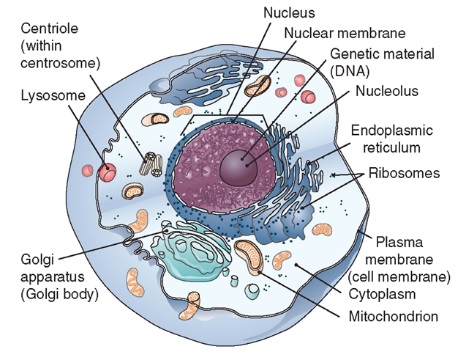
Cells are the basic unit of life and are found in all living organisms. The structure of a cell can vary depending on the type of cell and its function, but there are some basic structures that are present in most cells.
Here are the main components of a typical eukaryotic cell:
- Cell membrane: This is the outermost layer of the cell that separates the cell from its environment. It is a selectively permeable membrane that controls the movement of substances in and out of the cell.
- Cytoplasm: This is the fluid inside the cell that contains various organelles and structures.
- Nucleus: This is the control center of the cell and contains the cell’s genetic material, including DNA.
- Mitochondria: These are the powerhouses of the cell, where energy is produced through cellular respiration.
- Endoplasmic reticulum: This is a network of membranous tubes and sacs that are involved in protein synthesis and lipid metabolism.
- Golgi apparatus: This is a stack of flattened membranes that is involved in the modification, sorting, and packaging of proteins.
- Lysosomes: These are membrane-bound organelles that contain enzymes that break down and recycle cellular waste and foreign materials.
- Cytoskeleton: This is a network of protein fibers that provides structural support and helps with cell movement and division.
In addition to these structures, some cells may also contain other organelles or structures, such as chloroplasts (in plant cells) or flagella (in some types of cells).
It’s important to note that prokaryotic cells, such as bacteria, have a simpler structure and lack some of these organelles, such as a nucleus or mitochondria. Instead, their genetic material is located in the cytoplasm, and they may have other specialized structures, such as pili or a cell wall.
Cells have many vital parts that keep it functioning, and each has a very important role. The cell membrane is found in both animal and plant cells, and its primary function is to regulate what goes in and out of the cell. Chloroplast is only found in plant cells, and it captures energy from sunlight. It uses this energy to produce cell food, which is sugar. (Photosynthesis!) Cytoplasm is found in both types of cells, and it works to house gel-like fluids that support cell organelles. Endoplasmic Reticulum is found in both types, and carries substances, like proteins, to various parts of the cell. The Golgi Body/Complex is also found in both, and receives materials from endoplasmic reticulum, then distributes materials. The lysosome is only found in an animal cell, and serves to contain chemicals that break down certain materials, as well as breaks down dead cells. The mitochondria is in both types of cells is the powerhouse of the cell and produces energy for it. The Nuclear Envelope is in both types, and is similar to the cell membrane, except it protects the nucleus and regulates what comes in and out of it. The Nucleolus is in both types, and it’s function is to make ribosomes. The Nucleus, found in both types, is like the brain of the cell. It contains DNA, and directs all action , including reproduction. The ribosome, also found in both, serves to produce proteins. The Small Vacuole, found only in animal cells, transports and stores material, including waste. The cell wall, found only in the plant cell, helps protect and support it, as well as give the cell a shape.